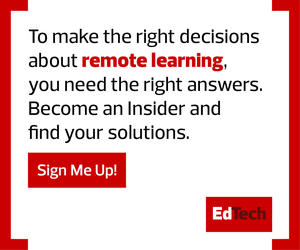In addition to supporting laptop deployments, tech carts and lockers also can be leveraged to support emerging technology requirements. “People are using them for VR goggles and 3D printers,” Gassen explains, “all the STEM equipment that needs to be mobile or shared among multiple classrooms.”
As Power Consumption Increases, Management Should Be Easy
With the pandemic-led surge of in-school devices, districts also are taking a close look at issues of power consumption. They’re seeking reliability and ease of management — the ability to diagnose power issues quickly and to remediate them in a timely manner.
As government segment director at Schneider Electric, Jeff Chabot points to an infrastructure monitoring, management and optimization tool like EcoStruxure as a way for IT leaders to address these concerns. “You can be looking at the health of your electric equipment and even monitoring that remotely,” he says.
Should a problem arise, a technician can be on the scene promptly, already armed with a thorough understanding of the issue. “That person is going to arrive with either the correct part or just a whole swap unit, and they will be able to fix the issue before it even becomes a problem,” Chabot says.
Power management tools also can help to optimize energy usage with options such as recommended configurations. All this will be increasingly important for districts in a post-pandemic world.
READ MORE: How will classrooms function differently following the pandemic?
“In this environment, that network has to be even more robust,” Chabot says. “Schools handed out tens of millions of laptops, notebooks and tablets during the pandemic. Now, all those devices are coming back to the classroom. You need a reliable network to support all of that.”
Access to the Cloud Enables Evolving Learning Environments
Another key technology supporting the future of K–12, Infrastructure as a Service (IaaS) offers access to the scalability and massive compute power of the cloud.
“This is all about agility,” says Herb Thompson, a senior state, local and education strategist at VMware.
“When the schools shut down and we went from on-campus to online overnight, everyone had to react very, very quickly,” he says. “We don’t know when that will happen again. There might be another cyber event, another natural disaster or even another pandemic that’s going to cause us to rock on our heels and make changes very quickly.”
With IaaS access, schools can be ready to respond to those rapid evolutions.
“IaaS allows them to scale up and down as they need to,” Thompson says. “Suppose a hurricane comes: The school system is able to basically shift IT operations and run the complete environment now in the cloud. When the emergency is over, it can fall back on its on-premises data center.”
DIVE DEEPER: How can K–12 schools protect valuable data from cyberattacks?
IaaS comes with a number of other advantages. When student information systems are run on a common platform, it becomes easier to share information and to conduct long-term longitudinal studies.
With learning management systems in IaaS, teachers can make available a wealth of learning resources. “When we start to get into the blended learning, that means they can use more of their classroom time for discussion,” he says.
A cloud-agnostic solutions provider, VMware makes it easy for districts to take advantage of the IaaS environment. “A server administrator can simply drag and drop applications from the on-premises data center to the cloud,” Thompson said.
As schools return to in-person learning, technology will play a key enabling role. Tech carts, power management tools and modernized infrastructure solutions all promise to ease the path back to in-classroom education.
MORE ON EDTECH: Influencer Allie Beldin explores innovation with educational technology.











